In the coming months I will be writing more posts again in our ‘How great things age’ series, which aims to illustrate the beauty of quality clothing over time.
Basically, it’s an antidote to the new clothing that it’s much easier to write about, and which most sites (especially social media) are dominated by. It shows not what you get now, but the reward in 10 or 20 years.
Because, while quality clothes can look good the day they’re bought, it’s often in the long term – as things are worn, cleaned and repaired – that they really show their value. Plastic does not do that.
Those upcoming articles will necessarily focus on my wardrobe. And while I do have beautiful examples – having started buying bespoke shoes and tailoring just over a decade ago – I don’t have anything that’s 30 or 40 years old (excluding vintage).
For that I have to turn to friends, and so today I’m going to highlight a jacket owned by tailor and friend Nicoletta Caraceni, in Milan.
The tailoring house that Nicoletta runs, Ferdinando Caraceni, was founded by her father. (No relation to A Caraceni – full history/explanation here.)
Ferdinando was a very elegant man, and when he died, Nicoletta inherited a sizeable wardrobe. He was bigger than Nicoletta, but not much taller, and so the jackets didn’t fit too badly – the sleeves might need to be shortened, the body slimmed, but otherwise it was OK.
That doesn’t mean that she could get a real bespoke fit, of course. Just that it could be something wearable, and still of the greatest quality. Plus deep emotional value.
The jacket Nicoletta is wearing here is about 50 years old.
She guesses it was made in 1971. There is a picture of her father wearing it in 1973, and it wasn’t new then.
The date on the label, in the inbreast pocket, has long been worn away.
(Side note: I find it funny how much I like these labels in my bespoke. I never thought I’d care that much, but I often find myself checking when a particular suit dates from. There is something special about having the moment captured, and stated. I almost want to add similar labels on my favourite ready-to-wear.)
Nicoletta’s jacket, in a densely woven black wool, is part of a suit.
The trousers don’t fit by some way, but they have a second use: Nicoletta has kept them for spare cloth, in order to patch and repair the jacket. She used it to patch the elbows, as you can see in the image above.
The edges of the jacket, where they would have rubbed on other surfaces, had become worn and frayed – mostly the front edge around the waist button and below, and the ends of the cuffs.
Here Nicoletta put black binding on, instead of cloth, as it was stronger and rather suited the jacket, given it was already redolent of black tie.
The lining has also been replaced more than once.
The hand-sewn buttonholes have lasted well, but the waist buttonhole was repaired at one point. Repairing usually makes most sense, as replacing buttonholes can be quite messy.
There was one buttonhole that was too worn away, on the bottom of the right sleeve, and here Nicoletta covered by doing the repair with a bright Italian tricolore. I don’t have an image of that, but it is on several of her jackets, including the pinstripe she is wearing here.
Few things are less my style than multicoloured buttonholes. Indeed, much of what Nicoletta wears is not my style – she often pairs jackets like this with jeans and cowboy boots.
But I really admire her approach to clothing. We have a similar passion for good clothes and fine craft, and ultimately this mixing of styles is very her: it has absolute integrity (in both senses).
A poorer quality jacket would not have lasted this well.
Anything that used fusing, to start with, would have seen the glue dry and peel away over time, distorting the front. Fusing has improved a lot in recent years, but this would still be its downfall in the end.
Caraceni tailoring, like much in northern Italy, has a strong shoulder but rather light structure in the body. Nicoletta often says that these lighter layers lose nothing in strength or durability, and her father’s jacket is pretty good evidence.
Any handmade tailoring is also easier to repair, for reasons we’ve gone into before (see video here on repairs, and here on alteration). There’s more cloth in the seams, and those seams are easier to open and work.
Of course, with a lot of bespoke there’s also a good chance that the cutter and coatmaker you go to for repair, are the same people that made that tailoring in the first place. This isn’t the case with Nicoletta’s jacket – the staff aren’t quite that old – but they are all familiar with the techniques, having been handed down in the workshop over the decades.
This jacket doesn’t look new, and certainly shows its age. The buttonholes look worn, and the hip pockets sag open (a good argument for flapped rather than jetted pockets, perhaps).
But in two distinct ways, this bespoke looks better than even new RTW.
First, the jacket still has the 3D shape and structure of bespoke, which gives it both better lines and a more personal shape.
And second, it has the beauty of age: it is unique, it has character; it has little details everywhere that hint at its journey over the past half century.
The first of those is the lasting appeal of bespoke make. The second is the appeal of all vintage clothing – except that, of course, it’s your own vintage.
The tailoring I have from Nicoletta – such as the cotton jacket below – is a long way from being this kind of vintage. But it’s lovely to think what it might look like after 50 years. At which point, perhaps, it will be worn by one of my daughters. They’re certainly getting tall enough.


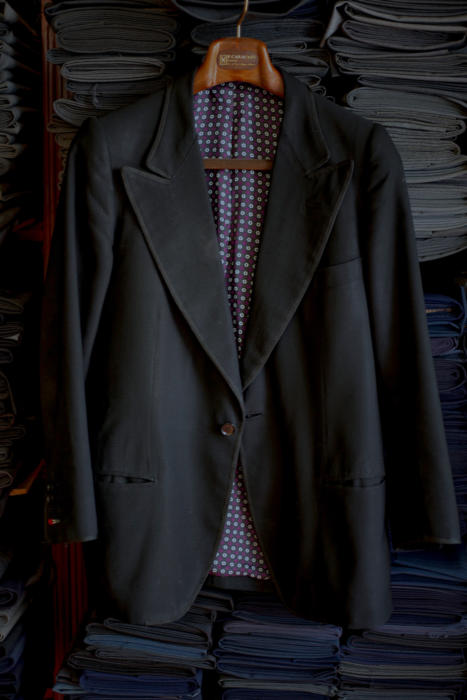
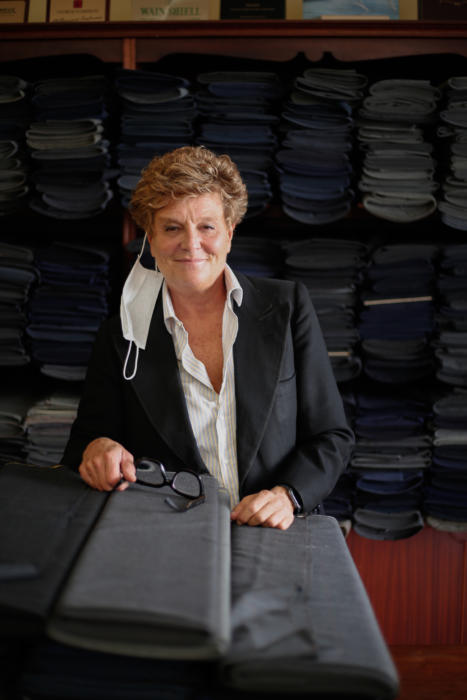
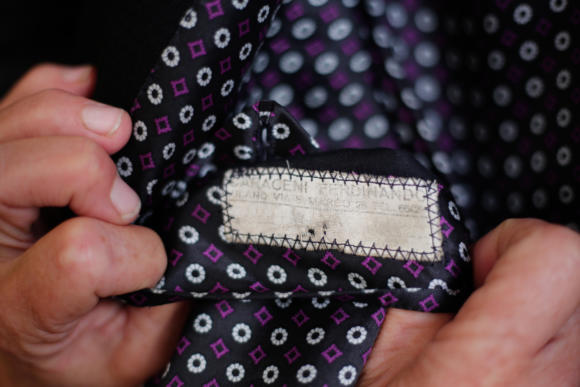
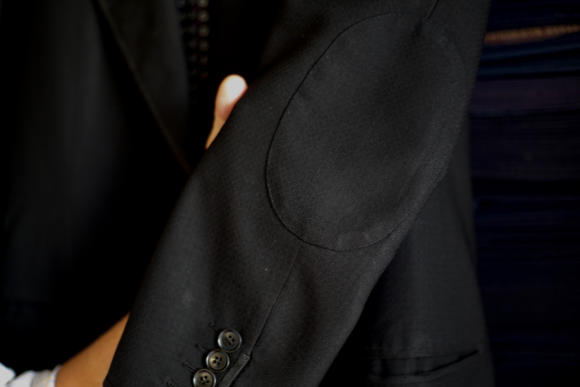
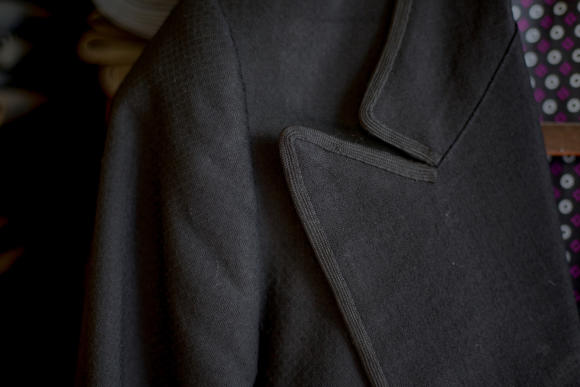
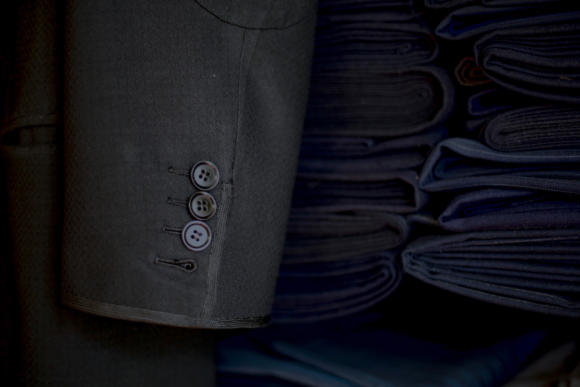
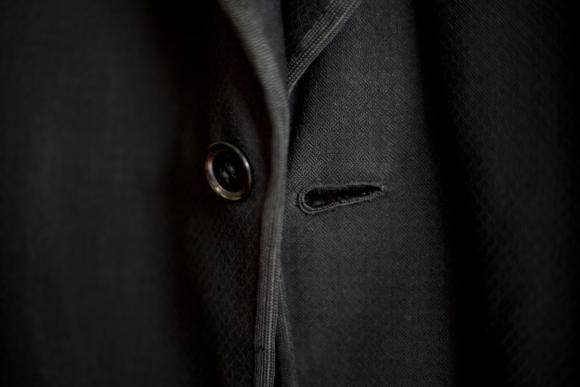
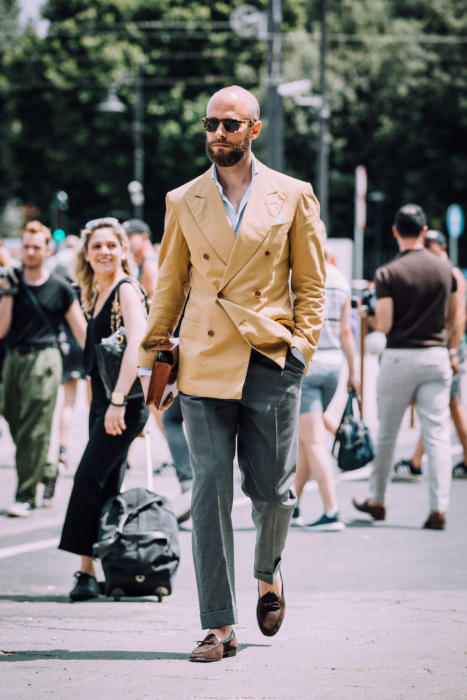


























the jacket does tell a story. however i am not sure i agree/understand your point no 1 around 3D shape and structure of the jacket. if this is a hand-me-down jacket and has been altered to fit the new owner, surely its no different from a RTW altered to fit someone? (assuming all else, construction, quality, etc being equal)
Well no, it is different, because all those last things are not equal. You still have much greater quality in bespoke compared to any ready-to-wear – pretty much no RTW brand is doing the quality work you’d have in any bespoke, from the hand padding to the seam inlay, the iron shaping to the hand finishing. And the 3D shape and structure are achieved uniquely by some of those.
It’s why some people seek out and collect vintage bespoke tailoring. There’s also an argument that someone will look better in bespoke made for someone else than RTW altered to fit them – something we touched on previously with Musella-Dembech, for instance
“ There’s also an argument that someone will look better in bespoke made for someone else than RTW altered to fit them.”
Whooooah !
Simon, you’ve laid the gauntlet there !
I’d be interested to hear more about that .
Sure, though it might take more than just a comment!
It’s basically about weighing up the benefits of fit vs bespoke 3D shaping and quality. And of course how closely that bespoke fits in the first place – which means that weighing up is different for every person and every garment
It’s obvious that if a bespoke jacket made for someone else, if it fits at all, fits incomparably better than RTW made to fit a very wide range of silhouettes. High armpit, chest structure that will drape pretty much regardless of what it contains (provided that it’s not too tight of course), hand padded lapels, the finishing…
thanks for your replies Simon, Bligh. i must admit your point re bespoke fitting better than RTW is counterintuitive. bespoke is designed to very specifically fit Elton John – with the idiosyncrasies in physique and all. whereas RTW is designed to fit Joe Bloggs. So intuitively, a tweaked RTW may fit better than a tweaked bespoke. Obviously, bespoke has better construction and overall better quality. I am referring to the fit only.
You’re absolutely right, but that just means that RTW will be more average, and bespoke more likely to be unusual in fit. Then it depends whether you’re average, or more unusual, and if unusual, then more like the unusual fit of that bespoke garment.
In general, most people will find more RTW garments that fit them OK, because the clothing is designed to do that. But that still means a lot of people will find bespoke that fits them pretty well too.
Interesting topic but lets look at the prevailing climate .
Social media , Instagram in particular , presents polished images of sharp cuts and well dressed people .
Even Saville Row is guilty of this . New , new and newer is the mantra.
But on a particular point of aged clothes that you don’t refer to , and the biggest problem I find, is the colour fades and so a garment is less useful because it can’t be ‘re-dyed’.
A particular example is turbans that I’ve seen re-dyed many years ago in India.
I know in developing countries people would have access to dyers but even in these countries folk are moving away towards western RTW.
Can bespoke clothes be dyed in the UK ? Are any cloths more resilient to colour fading ?
Interesting point. Yes, some cloths will fade less. Wool will fade less than cotton, for example, and you’ll notice fading less on lighter colours.
However, fading is something I like – it shows the age and the character. It’s a reason I like cotton suits for example.
I think it’s only an issue with the very smartest of clothing – a navy worsted for example. But even then it can have charm, as long as the suit elsewhere is well maintained, pressed and fitted.
Love this kind of posts. Thank Simon
Pleased to hear it Fernando – it’s not exactly ‘shoppable’ but perhaps a nice antidote to Cyber Monday as a result. (Or rather, as it should now be called: a whole week or more where things go on sale, despite other sales starting in about two weeks’ time)
Fabulous post.
As somebody who is lucky enough to be wearing his own vintage I can vouch for the fact that there is nothing more satisfying.
The feeling you get of smug reassurance from knowing that you made the right choice all those years ago.
The feeling that you are having fun knowing that you haven’t destroyed your soul or the environment with an endless round of consumerism.
The feeling that you are looking good in garments that have aged and faded with you and are all the better for it.
And that laugh out loud moment when some aspiring Young Turk asks you where you bought it from.
These feelings are difficult to surpass but to enjoy them you have great taste, buy quality classics, look after them and fastidiously ignore the superficiality and transience of what passes for fashion.
I too, enjoy these posts. Black items are difficult in photography to see the wear and repair. Perhaps future posts can be on lighter coloured materials to demonstrate better?
Sure, good point
Quality tells. Quality lasts. I bought my first bespoke jacket almost twenty-four years ago, a beautiful green Cheviot tweed with a red overcheck. I remember when it arrived, so stout I felt like I had to break it in. I’d never had anything like it. I still wear it, and still want to wear it. When I do it is not uncommon for someone to say, “beautiful jacket.”
You have written about whether bespoke is worth the extra cost, and often those articles attempt an objective discussion. But, as this article shows, a beautiful bespoke garment has an intrinsic value that is difficult to quantify.
Good point Rogey – there is character that comes through age and only bespoke often gets to that age
I can attest from my own experience the longevity of bespoke clothes.Over the last forty years I have commissioned many suits,jackets,trousers and overcoats.They all retain an elegance and durability that is impossible to find in RTW.
Hi Simon.
I do not doubt this suit’s quality or craftsmanship but I must confess, I’m having a hard time imagining a suit like this being wearable from a style point of view. It’s a black single button suit with peak lapels and jetted pockets. It seems the only thing missing for this to be a tux would be the covered buttons and the facings. Or maybe it would have been more fashionable 50 years ago when it was made? The photo of Nicoletta wearing the jacket seperately looks great but I fear it’s a look only she can pull off.
Yes, I think a little bit of unorthodox style is often required when reworking something made for someone else like this. And indeed for another era.
Still, it would certainly make a nice and very personal dinner jacket too.
Hi Hedric,
Sorry to disagree, even today this could be a sharp evening event suit! For Heaven’s sake, why do business suits seem to have become fashionable as event wardrobes? Even though they do not make sense at all from a strictly style point of view!
John
I will join the chorus of people praising this article series. I especially like when it circles back around to tailors or other people previously covered on PS.
Like bespoke labels, I like to sift through email receipts from time to time as a way to recall when I purchased something. It is not only fun to recall the purpose but can also help calibrate my awareness of an item’s value. I’m pretty aware of how often I wear something in its general rotation but often underestimate how old it is. A jacket that I’ve worn ten or so times seems far less useful when I am reminded that it is twice as old as I had suspected.
While I am inclined to agree with your claim that quality bespoke lasts longer, I suspect that a well-kept piece of good ready to wear wouldn’t look too different, assuming comparable initial fits (which is of course unlikely). The more important point is that we’ve no examples here with which to make the comparison. For anecdote’s sake, I have a half-canvassed rtw navy velvet blazer by Pierre Cardin from dad from the early 90s that I still bring out for holiday parties that looks in fine shape, no sagging even at the pockets.
I continue to wear Harris jackets,(owned by my father) and he had a superb wool coat via his father. I intend to pass both jackets onto my son. Luckily, we are all 5ft 10 ish with measurements which seem average.
The advantages of style over fashion. We should learn to treasure them.
Beautiful jacket and very interesting post. Black suits are obviously difficult to pull off however the texture of that cloth carries is very well.
On Ben’s point I have got at least three items which I still wear. They are all RTW
1. A pair of Brown derby shoes by Allan McAfee, in my opinion much better quality and last shape than Edward Green. This pair dates from about 25 years ago.
2. A hacking jacket made by Philips and Piper, of East Anglia, which I got to go to University 35 years ago.
3. A long grey wool and cashmere overcoat with turn back cuffs which my late father bought in the early 1950’s.
As a customer of bespoke, and a fairly ‘easy’ shape I can’t tell much difference between the fit of these clothes and the fit of bespoke. What is remarkable, however, is two things:
(a) the quality of the cloth – I haven’t seen anything like it in twenty years; even the most expensive mixed fibre cloths are nothing like these.
(b) the quality of work. There is evidently not the same amount of handwork as one would expect of bespoke (though I sometimes think the value of that is overstated by enthusiasts) but what is really remarkable is the quality of work turned out by what were, effectively, small British factories – now, sadly, long gone.
The question would be if you’d find that quality today?
I too have a pair of RTW shoes (black oxfords from Dack’s – a long gone Canadian maker) that have endured and are still a pleasure to wear.
I also have a Gore Tex anorak that I purchased 30 years ago. I have used it hiking, camping and alpine skiing. It’s still going strong and I often get questions about it on the slopes.
Don’t get me wrong, I definitely believe in buying items of high quality and wearing them over a relatively long period of time, and I am by no means somebody who buys „investment pieces“ only to replace them after one season of light wear, but 50 years of wear is definitely stretching it a bit. I think by spending a lot of (perhaps even too much) time on sartorial issues, dissecting every minute detail and getting too deep into the philosophical aspects of dressing, one might simply forget to take a step back every once in a while, and acknowledge the obvious: This item of clothing is worn out, and should be replaced.
I think it depends why it is being kept and worn. No one is suggesting this is how everyone should wear their clothes down, and certainly not all their clothes. But this has sentimental value, and it’s impressive how long good clothing can last in that way. Plus if it’s your style and you like it, there is a separate beauty in aged clothes – like the appeal of vintage.
Perhaps there is a cultural dimension to this as well. There seems to be a fondness of old, worn (out?) clothes in the upper classes in northern Europe at least. Some snobbish swedish podcasters jokingly says that a barbour wax coat only looks good if it’s at least 30 years old. Another one of their arguments is that it takes three generations to grow into a tuxedo. Not only that clothes become more elegant with time but also that style, manners, knowlegde and social connections accumulates across generations. It’s a pre-modern idea of elegance but to me it still rings a little true, uncomfortable as the idea is.
I completely agree, and yes there is historical precedent of that particularly in Northern Europe among the aristocracy. It’s partly a Protestant thing, but also a reaction to new money and the industrial revolution – old money turned up its nose at brash ways of showing off wealth, becoming even more subtle (a good thing) and snobbish (a bad one). The industrial families in Sweden were some of the most obvious examples, though England has a lot of that too – hence what became known as the English country house look, in interior decor and to a lesser extent clothing
I’d argue that brashness and need for things to be obviously new, or expensive, or fashionable, has pretty much only accelerated since then
It’s really nice to see sentimental value getting mentioned on a blog about style. I feel that when individuals too carefully curate how they present themselves to others they lose a sense of individual style. I’m always suspicious when I see someone’s clothes (or home, or possessions) and everything is generically tasteful or stylish.
Very good point Evatt. It suggests priorities have got a little mixed up somewhere along the line
Hi Simon,
I’ve really read this post with great interest! On the basis of the few comments I’ve also read so far, I realize yet again that among men and women alike, even those who happen to have a sense of style and value style as such, there’s a big devide that remains unbridgeable: those who are very excited by pristine cloths and those who aren’t that much or rather who would try to anyhow first “tame” their new purchases in order to feel confortable when wearing them. That can lead them to start wearing them at night or mix them with old cloths to make them unnoticeable, etc.
Obviously, Nicoletta belongs to the latter group.
I must confess that over years as PS reader, while I always enjoy reading your posts and the readers’ comments, I also enjoy identifying those who belong to this group for one specific reason: they definitely understand style or being stylish as a multifarious process, and hence as a kind of long game – not an instant one – above all played silently! That’s what prompted, for instance, Bruce Boyer warn his readers to remain alert and not let their old oxfords thrown away by their wives or girlfriends, which would surely be felt as a terrible defeat for the players they are expected to be!
“How great things age” is a reminder for these folks, not for the former!
John
Interesting article. Today I’m wearing my father’s POW Maurice Sedwell suit from 1983. Still look great! I remember going with my father for the final suit fitting- special times…
I greatly enjoy this series and look forward to seeing more to come. I have an original US Navy peacoat that is about the same age as this jacket – 50 years old – and has also aged beautifully.
Hi Simon,
Great article. I also love looking at labels on vintage/quality garments. I recently purchased a herringbone tweed wool 3/4 coat, single breasted with in a beautiful cut – I’ve had numerous positive comments – people just love to see it. I got it for a few quid in a charity shop. When I got it home, there was a 35mm film container (no film to process, sadly) with a receipt dating from 1991. I suspect the coat is much older. The maker’s label is obscured, so I can’t do any research(!). I’m never going back to fast fashion; I can’t bring myself to wear anything that isn’t produced with care. The price tag on the coat – £5.00…..
Thanks
Anthony
Wow, that sounds lovely. Thanks Anthony
I had two Hackett travel suits for work.
One gray and one navy
They were never fastened at work due to the eqpt we carried underneath but the lining rubbed through Ron my right side where a particular piece of kit sat.
I had that part re lined and carried on for a few more years till retirement.
They had served me well all round the world and I even had the trousers tapered, losing the pickets in the process( which I never used)
Good times